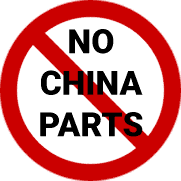-
All Orders are Fulfilled in the U.S.A.
-
All shipments must comply with U.S.A export laws.
-
No exceptions.

The only independent distributor
with a NO CHINA SOURCING Pledge

“We Proudly Support Intrepid Fallen Heroes Fund that serves United States Military Personal experiencing the Invisible Wounds of War : Traumatic Brain Injury (TBI) and Post Traumatic Stress (PTS). Please visit website (www.fallenheroesfund.org) and help in their valiant effort”.